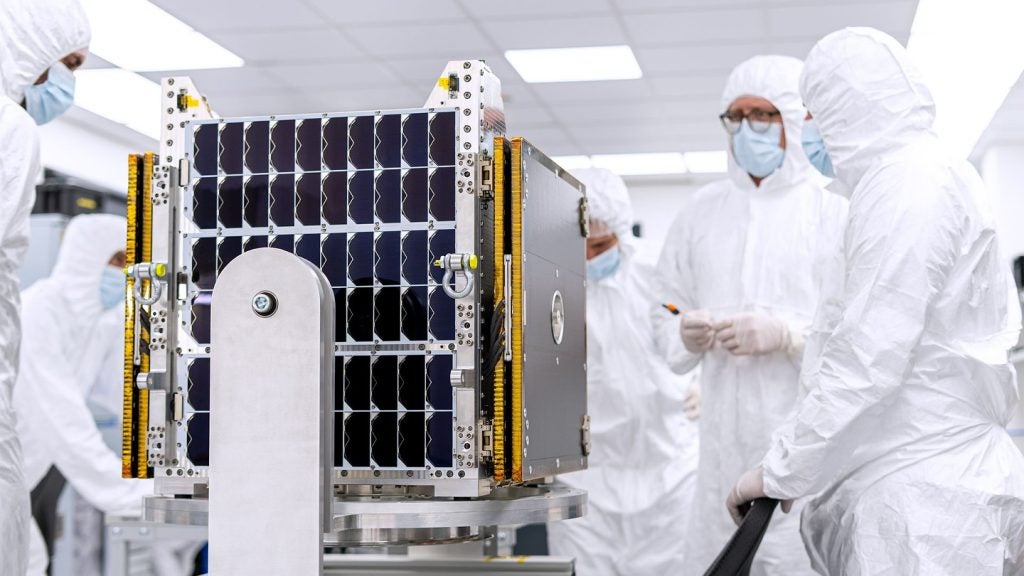
Fear of Russian invasion occupies Lithuania’s national psyche like little else.
435km separate the capital of Vilnius and the city of Smolensk on Russia’s western border, while Lithuania is hemmed in by the Russian exclave Kaliningrad to the west and ally Belarus to the south.
How well do you really know your competitors?
Access the most comprehensive Company Profiles on the market, powered by GlobalData. Save hours of research. Gain competitive edge.

Thank you!
Your download email will arrive shortly
Not ready to buy yet? Download a free sample
We are confident about the unique quality of our Company Profiles. However, we want you to make the most beneficial decision for your business, so we offer a free sample that you can download by submitting the below form
By GlobalDataIn the two years since the first Russian missiles hit Kyiv on 24 February 2022, and with the number of casualties having surpassed 500,000, Lithuanians have waited with bated breath for Putin to set his expansionist sights on Vilnius.
It is not difficult to see why Lithuanians are fearful – nor why Estonia, Latvia and Lithuania’s defence ministries unveiled a joint plan to line Russian and Belarussian borders with anti-mobility defensive installations last month.
“A lot of analysts say the next step [of Russian invasion] would be the Baltics,” says Major Donatas Palavenis, a Lithuanian Armed Forces officer and researcher at the Baltic Institute of Advanced Technology. “If you look at Vladmir Putin’s statements, this is very obviously where his next target is.”
Nato’s ‘Achilles Heel’
Lithuanian fears have not eased despite Putin’s assertion that Russia has “no interest” in Poland or the Baltics in his recent interview with Tucker Carlson.
“The total package of Lithuanian support to Ukraine amounts to more than €1bn ($1.08bn), half of which is military support,” Greta Monika Tučkutė, Lithuania’s Vice-Minister for Defence, tells Army Technology. “This is more than 1.2% of our GDP.”
Vilnius is acutely aware that the Kremlin will not readily forgive such steadfast support for Ukraine. But of greater concern is the significant geopolitical leverage Russia gains by occupying Lithuania.
Along Lithuania’s southwestern border lies the Suwałki Gap, a 100km corridor stretching between Poland, Lithuania, Belarus and Kaliningrad.
If secured, the Suwałki Gap could be used to bolster Russia’s military presence, adding to previous deployments of hypersonic missile-carrying warplanes at the Chkalovsk air base in Kaliningrad.
The Suwałki Gap also offers Putin direct land access to Kaliningrad, Russia’s only ice-free Baltic port and closest point to western Europe, via northeastern Belarus.
Military planners warn that the Suwałki Gap would likely be one of Putin’s first targets should he escalate the war in Ukraine to direct confrontation with a Nato member.
“The Suwałki Gap is not just Lithuania and Poland’s headache, but a regional headache,” Palavenis tells Army Technology.
If Russian or Belarussian forces occupied Suwałki, the Baltic region would be cut off from the rest of Nato.
Any land rescue would have to transit the Suwałki Gap, which Russia would bombard heavily from both sides. The only other alternative would be a combined air force and naval convoy crossing the Baltic Sea – somehow passing Kaliningrad’s S-400 missile batteries.
Vilnius has already clashed with Moscow and Minsk over this geopolitical flashpoint.
In June 2022, the Lithuanian government began restricting the rail transit of EU-sanctioned goods from Kaliningrad through to Belarus and Russia.
A year prior, Poland, Latvia and Lithuania accused Belarus of sending a record number of migrants over its borders, which Inga Langaite, CEO at Unicorns Lithuania, describes as “illegal migration as a form of terrorism”.
There is also mounting concern around Russia’s delivery of nuclear weapons to Belarus after satellite imagery revealed recent radiological decontamination exercises at the Bretsky Training Ground.
Tučkutė declined to comment on the security risks posed by the Suwałki Gap and Belarus when asked by Army Technology.
Lithuania leads Baltic defence spending
Lithuania’s fear of Russian invasion is based on historical and economic factors as well as geopolitics.
Moscow has twice before occupied Lithuania, before and after the Nazis invaded in 1941.
Russian tanks and soldiers even attacked Lithuania’s National Radio and Television Vilnius studio and other national institutions in January 1991 after Lithuania declared independence following 40 years of brutal Soviet occupation.
With the Russian language made mandatory in all former Soviet republics, the three Baltic nations have Russophone populations. Many in the Kremlin and wider Russia believe the Baltics should be at least partly under Moscow’s jurisdiction.
It is unsurprising, then, that Lithuania, Latvia and Estonia have prioritised the growth of armed forces since Russia annexed Crimea in 2014.
Lithuania reintroduced compulsory military service in 2015, incorporating a potential 100,000 reservists into its army. Around 4,000 Lithuanians of conscript age (19 to 26) are enlisted each year.
Three of these reservists are the Vizbaras brothers: Augustinas, Kristijonas and Dominykas, who volunteered in the Home Guard before conscription – and founded Vilnius-based Brolis Semiconductors, one of Lithuania’s emerging arms firms.
“We focused on what our domestic armed forces needed, because I had also joined the Home Guard,” Kristijonas Vizbaras tells Army Technology. “Back in 2014, despite the fact that we were already part of Nato, we were underequipped – dramatically.”
The Baltics have since paired conscription with a rise in military spending.
Through membership, Nato nations agree to spend 2% of GDP on defence. All three Baltic nations exceeded this figure in 2022, ranking among Nato's top ten in expenditure compared to economic size.
Lithuania’s increased defence spending has been particularly prominent, rising at an annual growth rate of 9.6% from 2021 to 2022, according to GlobalData. Vilnius’ defence budget is forecasted to surpass $2bn by 2026.
Nonetheless, the Baltics’ militaries are minuscule compared to the might of Russia, which recently announced a defence budget of 10.78trn roubles ($109bn), or 29.4% of total government spending, for 2024.
Lithuania’s “naked army”
Vizbaras is quick to identify Lithuania’s defence growth since the annexation of Crimea in 2014. However, he acknowledges the limitations of domestic arms production and military power.
“Even though I was fresh in the Home Guard, it didn't take much experience to understand that we have a naked army that is literally useless if something happens,” he says. “Bravery is very important, but, in the end, technology wins wars.”
While cooperation with Nato, European funding, military modernisation and the Ukraine war have all driven the growth of Lithuania’s aerospace and defence industry, various challenges remain.
It is a small domestic industry with a lack of exports due to the preference for US- or German-manufactured arms. This, in turn, is a barrier to companies looking to enter the Lithuanian market through collaboration or acquisition.
A limited market size did not, however, deter Norwegian aerospace giant Kongsberg from acquiring a 77% stake in Lithuania’s NanoAvionics last year, which NanoAvionics CMO Vaida Karaliūnaitė describes to Army Technology as “big achievement for a young company like us, in a country like ours without a strong space heritage.”

Lithuania’s MoD has also implemented various procurement programs, chiefly the Vilkas Boxer armoured vehicles from the Munich-based ARTEC consortium.
Vilnius is procuring four Black Hawk rotorcraft – with the option of two more – and several All-Terrain Hybrid Electric Vehicles, known as the Krampus Mk-1, from domestic company Ostara.
Palavenis says Taiwan’s burgeoning indigenous defence industry can be a prototype for Lithuania, pointing to the geopolitical pressure both nations face from a neighbouring adversary and the potential for military-commercial collaboration.
“Lithuanian armed forces will be involved much more than we are right now,” Palavenis says. “And there will be opportunities for active military persons to participate in or even take leading roles in developing indigenous defence capabilities.”
Would Nato come to Lithuania’s aid?
Vizbaras, meanwhile, points to Russia’s invasion of Ukraine as a turning point for the Lithuanian defence industry.
“When full-scale war came about, we were already ready – we saw it coming,” Vizbaras tells Army Technology. “When we saw that the war was about to begin, we donated a lot with the help of our government, so [Ukraine] had some of our systems already available. Those were unpacked on the very first morning after the invasion, on the outskirts of Kyiv.”

Brolis is a leading example of defence firms across the Baltics which have mobilised to support the Ukrainian cause.
Such efforts have prompted all eyes in Lithuania to swivel towards the US and NATO alliance’s commitments to both prolong military aid for Ukraine and defend the Baltics from any threat to the east.
Palavenis highlights the presence of the Nato Response Force (NRF) and Force Integration Units as steps the alliance has taken to fortify its eastern flank.
“It has become a political decision to defend covertly,” he concludes. “If Russian Federation troops step on Baltic or Polish soil they would be very hard to expel, as seen in Ukraine.”
Strategic considerations aside, the US and other Nato powers are, of course, obliged to defend an attack on any fellow member.
But domestic squabbles between Republicans and Democrats over the continuation of aid for Ukraine have left Lithuanians, Latvians, Estonians and Poles asking: would the US really come to our side if Putin invaded?




